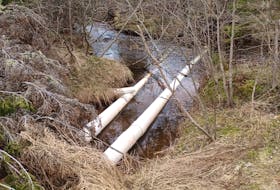A new scientific paper co-authored by Dalhousie University professor Hal Whitehead shows sperm whales quickly learned to take up new defensive strategies after they first encountered human whalers in the 19th century.
And the whales shared that knowledge among themselves in a clear demonstration of whale culture, Whitehead says.
The paper, written with researchers Luke Rendell and Tim Smith, was published Wednesday by the Royal Society.
“The first idea came to me about two years ago when there was a symposium at the University of Victoria in B.C., arranged by historians of whaling – the people who read the writings and looked at the records of the whalers,” Whitehead said. “And there were a couple of historians there who suggested that the whales were quickly developing methods of avoiding whalers by learning from each other.”
A well-known cetacean researcher, Whitehead found the idea particularly interesting.
He also realized that the logbooks of those early whalers, which in some cases were kept fairly consistently over long periods and many ships, were preserved in museums in New England and had been digitized. The information was available online for free at whalinghistory.org.
His team looked at the logbooks of the American whalers who hunted sperm whales in the North Pacific from 1818 through the next 30 years or so.
The whales in that region had never encountered whalers before the Americans came for them. The whaling industry started elsewhere in the world's oceans and were led by the British and other nations, but in the North Pacific, it was these American whalers who were the first and who kept such good records.
The researchers could look at the logs of all the days they saw whales and how many they caught on that day and then could compare that with later logs as they progressed.
“What we were interested in was how the success of the whalers changed as their whaling got going in the North Pacific,” Whitehead said. “And the remarkable finding, to me, at least, was that their success dropped by about 60 per cent over three to five years.”
This was not that the whales couldn't be found, he added. This was success or failure after the whales had been sighted.
“Obviously (the whalers) were unhappy,” Whitehead said. “It used to be so good and Buddy had been here three years before and was killing whales like nobody's business and they were having a very had time of it. And so they wrote about that and gave potential explanations.”
The next step, thinking about the causes and presenting them, was more complicated.
The possibilities included that the first whalers were experts and better than those that came after, that they had taken the particularly vulnerable whales – the sick, old or less intelligent ones – or that the whales adapted and taught these new strategies to others.
The data analysis suggested it was the last possibility.

Previously, the primary threat in the ocean to sperm whales was another predatory whale species – orcas, or killer whales, Whitehead said.
“I've watched killer whales hunting sperm whales and the sperm whales have a very clear defensive way: they form these tight groups, baby in the middle,” and drive the orcas off.
He theorizes they probably tried the same with the whalers but this formation just made it easier for these new predators to close with them and drive harpoons into them.
The whales quickly figured out this wasn't a good strategy, Whitehead said.
In a time when the main whaling vessel was a tall ship, dependent on wind, which would send out smaller open boats propelled by oars to get close to the whales and attack using harpoons and lines, the whales began swimming fast upwind, were diving deep, and were even attacking the whalers in their wooden boats.
“What seemed to have been happening was the whales were learning ways to get away from the whalers – defensive things,” Whitehead said. “And they were learning them very quickly. So quickly that it looks like they were learning them from each other, it wasn't just their own experience. But naive whales, if they were with a whale who knew how to avoid the whalers, would adopt the effective ways of avoiding the whalers.”
Whitehead's team suggests the adaptations happened within one or two encounters with the whalers.
“I think what it shows us is that sperm whales can learn important things very fast and it can be communicated over a very large area. It's a form of whale culture, and in some ways it's a rather new form because we've looked at whale culture in terms of things which are quite stable – whales learning dialects from their parents and so on – but this is a remarkably fast and wide-spread change in whale culture.”








